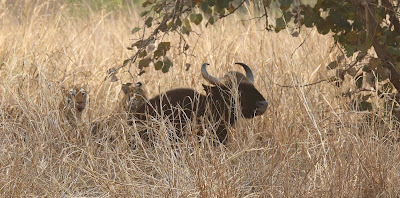Pench Tiger Reserve
It was for quite sometime that I was planning a trip to the Pench Tiger Reserve in the Seoni district of M.P. India. Finally I booked my safaris in the last week of November 2016 and landed at Nagpur, the nearest airport . Pench from there is about 97 kms away. It takes about ninety minutes time to reach there by car.
Pench is quite historical . You find its mention in the Ain-e-Akbari of Abul Fazl . But it was late Rudyard Kipling whose 'Jungle Book' gave it the real name and fame. The 'Jungle Book' incorporates its setting and topography from Robert Strendale's books 'Seonee' and the "Denizens of the Jungle'. And "Mowgli", the fascinating hero of Kipling's 'Jungle Book', portrays the wolf child who was caught by Lieut. Moor in the jungles of Seoni in the year 1831 near the village of Sant Vavadi located just ten kilometres away from Seoni and about whom William Sleeman wrote in his book 'The Journey Through the Kingdom of Oude". It is believed that Rudyard Kipling had visited Pench while he was in the service of erstwhile state of Dewas.
Pench Tiger Reserve derives its name from the river 'Pench' which flows through the reserve from north to south dividing it in two equal parts and in two revenue districts that is Seoni and Chindwara respectively. Standing on the Mahadev Ghat side you are in the geographical limits of Seoni while the other bank on the opposite side falls in the district of Chindwara.
Pench Tiger Reserve was upgraded to 'National Park' in the year 1983. It comprises an area of 758 sq km .
Dense,dark and deep that is how I will describe the Pench forest at this time of the year. Right from entering the Turia gate, the forest on both sides of the jungle road captivates you with it beauty. Its teak tress are simply magnificent . Straight and tall reaching to about 100 feet in height ! Its two tourist zones called popularly as route 1 and route 2 take you around the forest. Route 1, in comparison to route 2, is quite hilly and preferred by the tourists for tiger and leopard
sightings. However both the routes are rich in their natural beauty.Pench hosts a variety of wildlife, flora and fauna. Tiger, Leopard , Indian Bison. Jackal, Blue Bull , Spotted Deer , Sloth Bear, Black faced Langur, Wild Boar and Sambhar Deer are some of the wild animals found here. The interesting animal character 'Tabaqui'- the Jackal of 'The Jungle Book' has a good population here and so is of 'Bagheera'- the Leopard. But I didn't see any wolf . Among the birds you find Parakeets, Crested Serpent Eagles, Crested Hawk Eagles, Owls, Green Bee Eaters , Blue Jay's, Peacocks. Jungle Fowls , Drongo and many water Birds.
My keenness to sight the big cats of Pench was successful on my last safari almost around the closing hours. While coming back I met a jeep on the way which informed that the 'Raiyakassa' , the famous male tiger of Pench Tiger Reserve, was still at the banks of 'Beeja Matta' waterhole. My driver reversed and speeded back and as luck would have it I got the feline walking on the bank of the water hole . It scat marked its territory and then descended down in the waterhole area. The daylight was almost gone and darkness has started setting in. However I jacked up the ISO setting and got some shots just for the record.
Pench Tiger Reserve is beautiful indeed. I will visit again in May 2017.
<script async src="https://pagead2.googlesyndication.com/pagead/js/adsbygoogle.js?client=ca-pub-2331515138562989"
crossorigin="anonymous"></script>























